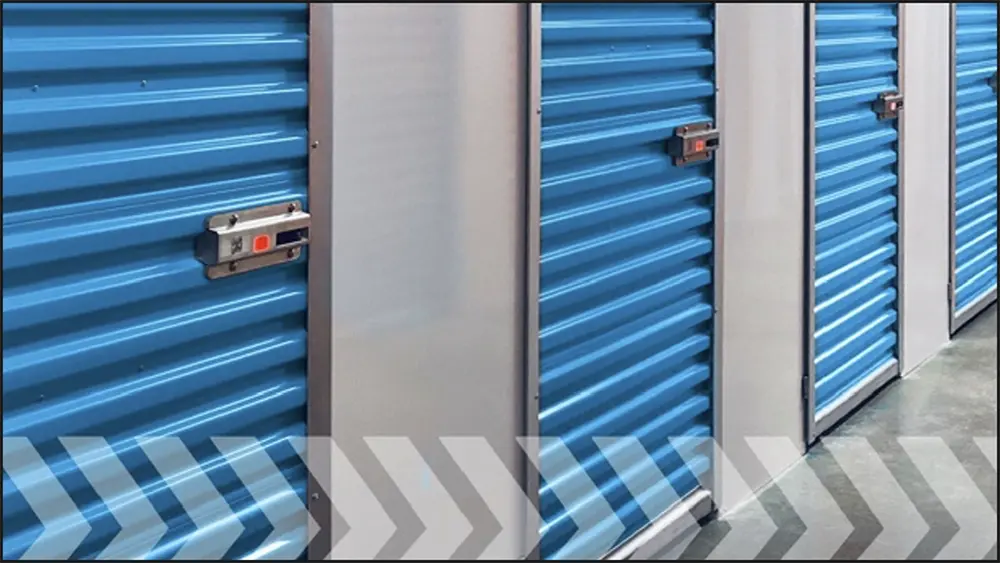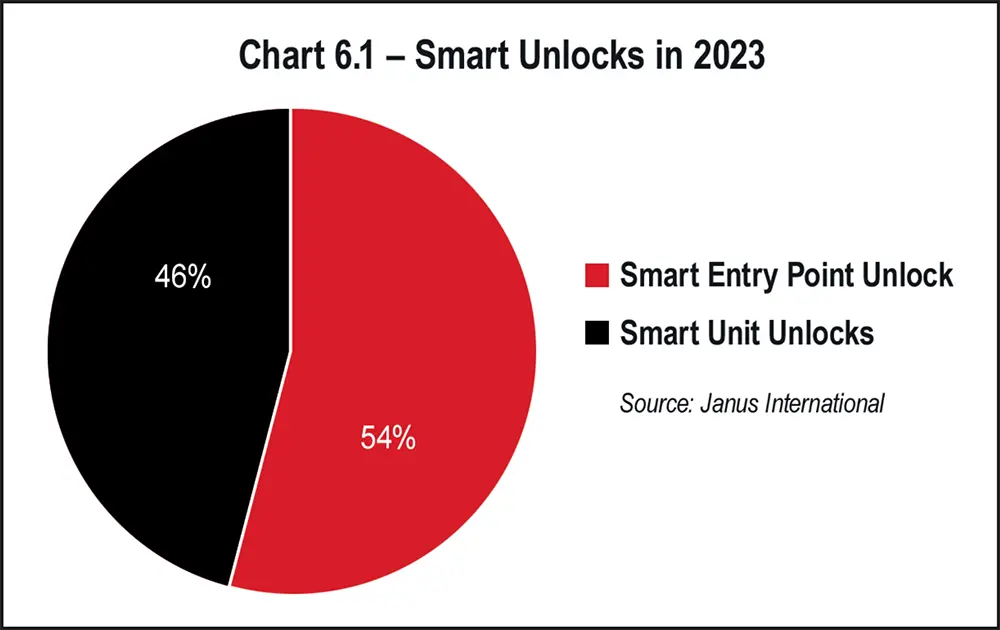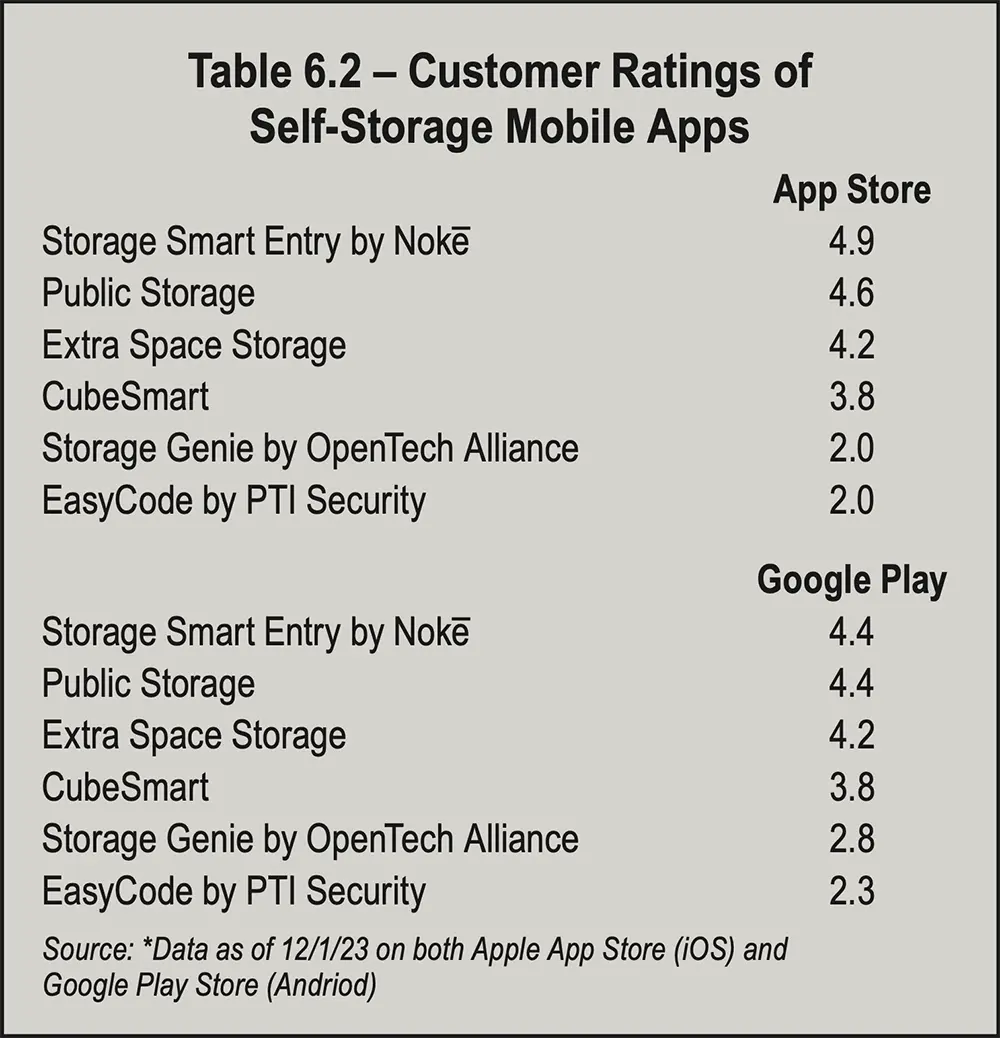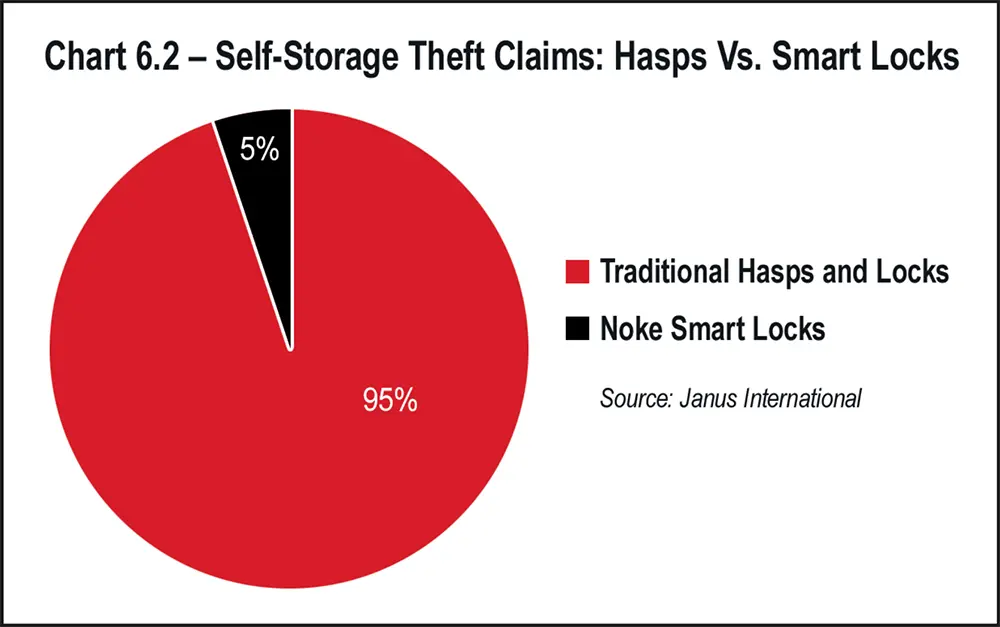
the rapidly evolving landscape of the self-storage industry, the integration of technology has become paramount to success. Embracing smart, integrated technology is not merely a trend but a strategic imperative that empowers self-storage businesses to optimize operations, enhance customer experiences, and stay competitive in an ever-changing market.
- Can a customer move into your property without someone manually contacting them?
- Can that same customer move in without someone needing to remove a lock from their unit door? If so, that’s half the equation. The other half is how much visibility and control you have over your property remotely.
- Have they left their door open?
- Can you see if the customer has shared their access?
- How many times have they opened their unit?
- Are they a business customer?
- Has someone else opened their unit?
- Has there been any motion or other activity in their unit?
- Is your delinquency and auction process automated?
Smart technology enables us to gain valuable insights that have previously been unavailable to self-storage owner-operators. For instance, in Table 6.1 and Chart 6.1, smart technology allows us to see not only when entry points are accessed but also how frequently individual units are being unlocked. Smart technology also provides an enhanced level of security and can reduce the number of theft claims by as much as 95 percent.
- Smart locks and IoT sensors
- Tenant-facing, smart mobile apps
- Smart facility access, cameras, and monitoring
- E-leases
- AI and chat
- Autopay
- Website
- Property management systems
- Revenue management systems
- Online auctions and collections
Smart Locks
It seems smart locks and smart access products are dominating more and more industries. Self-storage is no different. Today, you can give your babysitter access to your front door for a number of hours, allow a delivery driver to open your garage door to put your packages inside, and even skip check-in at the front desk of a hotel by getting access to your room through your phone. While use of smart locks in storage is much the same as these scenarios in other industries, the financial implications are larger. Just think of how much your staff could get done without manual lock checks, overlocking and overlock removal, cutting locks, dealing with lost keys, and prepping units for online rentals. Without the burden of these manual tasks, your staff can keep up with your facility’s social media, sell vacant units, provide customer service to your tenants, maintain the facility, and respond to any inquiries. There are many benefits to smart locks in relation to operational efficiency and tenant convenience, but data could be the largest benefit of smart locks on your property. With some smart lock products available in self-storage, you can see not only how many times a tenant has accessed their unit but also who gained access (a tenant or their shared users), how long units were opened, and what units were left open. This data can tell you a lot about your tenants and the security of your property.

Mobile Apps
From airlines and hotels to retail stores, almost every industry is utilizing mobile apps. Mobile apps allow you to engage with customers in a way most people didn’t think possible 15 years ago. Taking airlines as an example, a person booking a flight can control the entire process from a mobile app. They can book the flight, select seats, check in, and even get a boarding pass in their app. Mobile apps can help storage tenants have a similar experience as well. When a tenant rents a unit online, they can download an app to gain immediate access to the facility and even their smart lock if a facility has deployed that technology. Some mobile apps available to operators can even link to a payment portal which allows tenants to enroll in autopay, change card details, and make a payment on a delinquent unit. Some mobile apps even allow tenants to transfer to a different unit or rent an additional unit. Being in the palm of your tenant’s hand helps your operation become stickier to that person. Using other industries as an example, if you have a hotel’s app on your phone, you are more likely to book with that hotel over a competitor. The same idea applies to storage tenants.
In Table 6.2 above, you can see that self-storage tenants are quickly adopting mobile technology. In fact, in a recent tenant survey, we found that 89 percent of tenants found the Nokē Smart Entry app easy or very easy to use. It’s no wonder that we’ve seen such growth in storage operators adopting mobile app controlled smart locking and security technology. Over the past year, the number of tenants using the Nokē system increased 133 percent, from 780,000 to 1,825,000 tenant users. Additionally, self-storage tenants used smart technology to access smart devices more than 33 million times in 2023.
Sensors
Proactively monitoring the state of your facility and individual units is now possible for self-storage operators. Different sensors can help you monitor temperature, humidity, unit intrusion, and even open entry points. For climate-controlled facilities, it is important to know about temperature and humidity anomalies before your tenants discover them on their own. Armed with this information, you can remotely take action or deploy maintenance personnel to your facility to address the issue. Armed with intrusion detection sensors, you can stay ahead of theft claims and be aware if someone is trying to live in their unit, which is one of the biggest liabilities in our industry. Tenants living on site can be a major threat to your facility’s security. Being able to see motion inside of a locked unit can not only alert you to theft but also point out attempts to live on site. Many industry-leading smart locks incorporate thermal motion sensors to provide an even more robust level of security and motoring than electronic smart locks alone.
Facility Access
Providing access control for your facility is a baseline security expectation of your customers. Facilities without controlled access to gates, elevators, and other access doors are immediately at a competitive disadvantage. With most property management systems, the code generated to send to your access control system can be set to be a certain number of digits. With too short of a code requirement, potential thieves can guess a random code and gain access to the property. It is best practice to make your code requirement at least six digits. With some access control providers, you can provide exclusive digital access to your facility’s entry points, which ensures that a person accessing your facility indeed has the proper access to enter. Additionally, you can see exactly who is entering the property since shared users must be registered. With coded access, there is no way to tell if a tenant is entering, or if they have shared their code with another person. Access control tells you who is coming at what times and allows you to control who comes to your facility and when.
Website
Your website can be considered your best salesperson, and it is increasingly becoming the first interaction your customers have with your business. In fact, today, more than ever, it is the only touch point a customer will have before renting a unit. In 2023, online revenue in the United States has continued to experience unprecedented growth, with projections for 2023 exceeding $1.1 trillion, as e-commerce remains a driving force in the nation’s economy. The increasing prevalence of e-commerce platforms, coupled with a surge in digital services and the ongoing digital transformation across industries, has contributed to the increase in online revenue. Businesses have adapted to changing consumer behaviors, with a heightened emphasis on digital marketing strategies, personalized online experiences, and seamless transaction processes. The adoption of advanced technologies such as artificial intelligence, augmented reality, and virtual reality has further enhanced the online shopping and user experience, driving higher conversion rates. A robust, customer-friendly, mobile-responsive website with online rental capabilities and click-to-live chat or click-to-call options for customer service are as critical for modern storage customers. As consumers increasingly rely on the internet for their purchasing decisions, it has become even more critical for self-storage owner-operators to offer a fully automated online rental paired with a mobile move-in experience.
Autopay
The importance of offering autopay services in the storage industry today cannot be overstated. Autopay, or automatic payment, provides a convenient and efficient way for customers to settle their bills or recurring payments without the hassle of manual transactions. For storage operators, implementing autopay systems streamlines the payment process, ensuring timely and consistent revenue flow. This not only reduces the administrative burden associated with chasing payments but also minimizes the risk of late or missed payments, enhancing overall financial stability. Additionally, offering autopay demonstrates a commitment to customer satisfaction by providing a user-friendly and hassle-free payment option. It fosters loyalty and trust among customers, as they appreciate the convenience and reliability of having their payments automatically deducted. In an era where streamlining efficiency is paramount, businesses that prioritize and integrate autopay options into their payment systems stand to benefit from improved customer relationships and a more robust financial foundation.
E-leases
Embracing electronic leases not only streamlines the leasing process but also caters to the growing demand for efficiency and convenience among both self-storage owner-operators and tenants. Electronic leases eliminate the need for traditional paper documentation, reducing the administrative burden, minimizing errors, and accelerating the overall leasing cycle. Moreover, e-signatures provide a secure and legally binding way for parties to sign agreements remotely, enabling swift transactions without the constraints of physical proximity. This digital approach not only enhances the speed of lease execution but also contributes to a more environmentally friendly and sustainable business practice by reducing paper consumption. Overall, offering electronic leases and e-sign options not only aligns with the pace of the digital age but also demonstrates a commitment to customer satisfaction through a modern, accessible, and efficient leasing process. With electronic leases in place, your customers can select their unit online, electronically execute their lease, and receive an automated text message upon rental that includes a link to your branded mobile app and a one-time activation code. Once they download the app, enter their code, and create a password, they’ll be ready to access the facility and their unit directly from their device within minutes.
AI & Chat
Artificial Intelligence (AI) became an increasingly hot topic in 2023, and self-storage is not immune to these discussions. Generally speaking, AI provides businesses with tools for data analysis, pattern recognition, and decision-making, thereby enhancing operational efficiency and productivity. Through machine learning algorithms, AI enables businesses to extract valuable insights from vast datasets, facilitating data-driven decision-making processes. AI-driven technologies such as chatbots and virtual assistants enhance customer interactions, providing personalized experiences and improving overall customer satisfaction. Self-storage owner-operators can leverage AI to optimize facility management by implementing smart monitoring systems, predictive maintenance, and automated customer service solutions, enhancing operational efficiency and providing a seamless experience for clients.

Revenue Management
To maximize your top line, not only does your facility need to be stabilized but a revenue management practice should be in place. Many operators are uneasy raising rates on tenants (particularly long-time tenants) for fear of a mass exodus. The reality is a revenue management strategy does not need to be sent to all tenants. With the use of revenue management products and analysis of tenant behavior, your strategy can target specific groups of tenants who are less elastic to these pricing changes. Using revenue management technology, you may also see a limited inventory of certain unit sizes in your market. If this is the case, the street rate is likely higher than what your existing tenants are paying for this unit size. If a tenant moves out due to an increase in this scenario, you are likely to replace them quickly at a higher rental rate. Revenue management systems can take many different factors into consideration and help you effectively implement your strategy. Leveraging the data generated by smart locking and smart entry technology fuels revenue management by offering valuable insights about tenant behavior.
Online Auctions
Auctions are not an ideal part of storage. They are, however, a necessity. While we do not like to think about our tenants going so far into delinquency that their property needs to be auctioned to recoup their missing rental revenue, it does inevitably happen. Online auctions are a good way to automate this process while ensuring adherence to all local and state delinquency laws. An error in handling the auction process could cost your operation a lot of time and money. By using an online auction service, your facility is protected from the liability of mishandling the process. An additional benefit comes in the way of moving the process from on premises to remote. Your visiting tenants will not see the sideshow of a live auction occurring. Furthermore, you have less people entering the property for whom your staff needs to grant access. While an online auction is in process, your staff can stay focused on their job instead of monitoring the entry and exit of auction bidders.
Property Management Systems
The most important element of a property management system in self-storage today is its ability to fully integrate with innovative technology, including smart locks and smart facility entry products.
1. Operational efficiency and virtual management
- Labor savings
- Delinquency and auction automation
2. Enhanced security
- Reduction in theft and break-in claims
- Enhanced reporting and visibility
3. Improved and more modern customer experience
- Rental and payment automation
- Fully automated move-ins
4. Data and revenue generation
- More robust revenue management
- Enhanced reporting and data
- Consumer behavior
Operational Efficiency And Virtual Management
The importance of overlocking at the individual unit is paramount. Even though most facilities lock out delinquent tenants at the gate, delinquent tenants can and do get past the entry point and to their unit. According to data gathered by Janus International, over 150,000 attempts were made by delinquent tenants to get into their units from November 2022 to November 2023 at facilities using smart locks. With this in mind, the overlock process remains a large headache to most managers in our industry. If a facility is on first of the month billing, the manager will go out with a bucket of red locks to manually lock each delinquent tenant out of their unit. When tenants pay, the manager has to go out after each payment to remove the overlock. This can happen multiple times a day throughout the rest of the month. If a facility is on anniversary billing, the manager may be going out to overlock units multiple times per week. The same situation exists for removing these overlocks. This overlock and overlock removal process can be completely automated with the use of smart locks. When a customer goes into overlock, their access is automatically revoked electronically. When the tenant pays, their access is then automatically restored. The use of smart locks can completely take manual overlocking and removal out of the equation for storage operations.
Some smart locks in the industry can standardize the way you handle the auction process as well. With these solutions, you can control who manages the auction process so the same person can assign access for managers to take pictures and even set how many times the unit can be unlocked during the auction process. The auction process is a minefield for operators, and the use of smart locks is another way to ensure processes are being followed properly. Combining adoption of online auctions with smart locks can greatly reduce liability in this process.
In addition to streamlining the move-in process and virtually eliminating the manual tasks associated with adding and removing overlocks, smart locks and smart security tools provide valuable, labor-saving data that can help self-storage owner-operators reduce or even eliminate on-site management. This frees up operations teams to run multiple properties remotely from a central hub or focus their time on marketing and other revenue generating initiatives rather than manual tasks like lock checks and overlocking units.
As shown in Table 6.3 above, more than 50 percent of new renters are online renting units after hours, but they’re also onboarding themselves with smart entry and accessing the facility and their unit without going into the office to speak with anyone. In addition, smart locks provide remote management tools that allow virtual managers to open unoccupied units remotely for tenants who want to see their space before they move in. Once on site, tenants can click the “locate my unit” button in their mobile app to visually and audibly receive directions to their space. Finally, in-app links to your mobile friendly payment page allow past-due tenants to pay their bill via their phone and restore their access immediately.
Enhanced Security
One of the most compelling things about smart technology is that it not only eliminates tedious, manual processes for owner-operators but also provides a higher level of security than traditional storage hasps and manual locks. In fact, Chart 6.4 shows that Nokē smart units are 95 percent less likely to have paid theft claims than traditional hasps with manual locks. That dramatic reduction in theft and vandalism often creates valuable revenue share increases for storage owners; it also virtually eliminates the potential black eye of dealing with negative reviews and news coverage associated with theft claims.
Improved Customer Experience
The transition to electronic smart locks has revolutionized the customer experience in self-storage in much the same way as the guest experience was elevated in the hospitality industry. Mobile app-controlled locks offer a frictionless check-in process, eliminating the need for physical keys and gate codes. Tenants can now conveniently access their unit using their smartphones, providing a level of convenience and sophistication that aligns with modern expectations. This streamlined process not only enhances customer satisfaction but also contributes to operational efficiency for staff.
In today’s self-storage landscape, where customers seek secure and flexible storage solutions, electronic smart locks offer unparalleled advantages. Customers can use mobile apps to access their storage units at their convenience, and this flexibility is particularly beneficial for individuals who may need to retrieve or store items outside regular business hours, providing a 24/7 accessibility solution.
Data & Revenue Generation
For self-storage facilities operators, smart locks with mobile app control facilitates efficient management and monitoring of access points and units. Additionally, industry-leading smart locks have thermal motion sensing compatibilities that can help deter break-ins as well as identify tenants living in units. Staff can remotely grant or revoke access, track entry and exit times, and receive real-time alerts for any suspicious activities. This level of visibility also enables owner-operators to leverage unit access data for preventative maintenance as well as generate additional customer behavior based rental increase opportunities. Referring to Table 6.3, 19 percent of smart entry system users have shared digital keys with two or more people this year. Layering unit size, key share, and access history data can help operators identify commercial or heavy-use customers for more targeted rent increases.
What all of this means is simple: Smart technology is here to stay, and it isn’t simply the luxury add-on that it once was. It’s an expected and crucial part of a facility’s success, today and in the future. And as the data shows, it can enhance both an owner-operator’s level of security as well as their bottom line.




